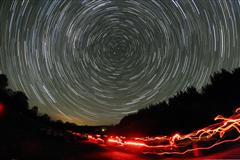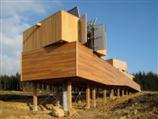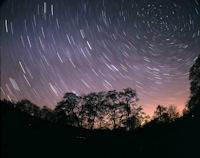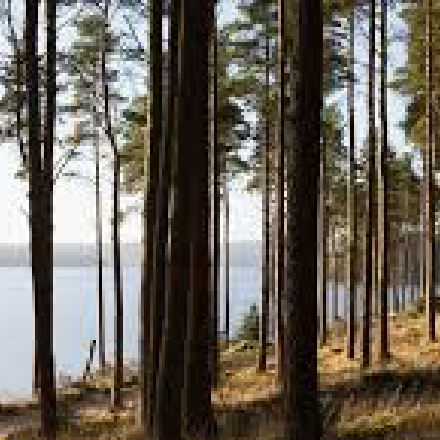Dark Skies News
4th October 2013
 A bid to create Europe's largest area of protected night sky has now been lodged with a global organisation campaigning to keep the world's skies dark.
A bid to create Europe's largest area of protected night sky has now been lodged with a global organisation campaigning to keep the world's skies dark.
The move to designate nearly 1500 square kilometres of Northumberland as England's first Dark Sky Park is being considered by the International Dark Skies Association (IDA) based in Tucson, USA.
A decision is expected before Christmas.
Kielder Water & Forest Park Development Trust, Northumberland National Park Authority and Kielder Observatory Astronomical Society have been working on the bold plan for two years.
Widespread support has come from residents, local councils, businesses, tourism agencies, wildlife campaigners and scientific organisations, including Jodrell Bank and the Royal Observatory at Greenwich
Key points in the 80 page bid document reveal that:
1. More than 300 light meter readings have been taken underlining that Northumberland has the largest expanse of truly dark night skies remaining in England.
2. Kielder Observatory has shared the wonders of the Universe with over 43,000 visitors since it opened in 2008 and further growth is forecast.
3. A unified Lighting Master Plan has been endorsed by the Northumberland County Council and the Northumberland National Park Authority to protect our night sky from wasteful light pollution in future years.
4. A lighting audit reveals that 75% of external lighting within the proposed Northumberland Dark Sky Park complies with IDA guidelines – the bid includes plans to improve this still further.
5. Forestry Commission, Northumbrian Water and Greenhaugh village are just a few of the places and organisations already making changes to their lighting to enhance the dark skies within the proposed Dark Sky Park area.
6. Local businesses are working to develop new astro-tourism activities. Some have already run stargazing packages and more business training seminars funded through the programme are planned.
7. Northumberland County Council's street light replacement programme will make a significant contribution in protecting the night sky through the use of more energy efficient and fully shielded lights. Maintenance costs will also be slashed by 60%.
8. More Dark Sky Discovery locations will be created in the Dark Sky Park where people can enjoy stargazing.
Elisabeth Rowark, Director of Kielder Water & Forest Park Development Trust, said:
“We have worked very hard to put together a professional and compelling bid document. We can't take anything for granted, but we have a great story to tell about our long-term commitment to protecting our night skies in Northumberland and engaging with the public. Northumberland Dark Sky Park has a wonderful ring to and would provide yet another reason to visit this wonderful part of England, especially in the darkest months of the year.”
Duncan Wise, Visitor Development Officer with Northumberland National Park Authority, added
“This is a very ambitious bid which would create one of the world's largest areas of protected night sky. But this is about more than just admiring the breath-taking beauty of the heavens. It's also about retaining the tranquil rural character of Northumberland and supporting local businesses to tap into the growing public appetite for stargazing.”
Gary Fildes, Founder Director and Lead Astronomer at the Kielder Observatory, said:
“Winning Dark Sky park status will only serve to enhance the visitor experience and ensure that we maintain the dark skies for future generations to look out into the universe and wonder about our place in it. So much of the UK is blighted by light pollution which makes places like the Kielder Observatory so very special.”
Keep up to date the dark skies quest at:
- www.visitkielder.com/play/discover/dark-skies
- www.northumberlandnationalpark.org.uk/visiting/thingstodo/stargazing
7th November 2012
 Star pictures by Dave Thompson, amateur astronomer from Medomsley, County Durham, taken at the Kielder Forest Star Camp.Stargazers capture stunning views of Northumbrian skies.
Star pictures by Dave Thompson, amateur astronomer from Medomsley, County Durham, taken at the Kielder Forest Star Camp.Stargazers capture stunning views of Northumbrian skies.
Moves to gain Dark Sky status for up 400 square miles of Northumberland are gathering pace as stargazers reveal the stunning beauty of the region’s starry skies.
An audit of external lighting is underway in Kielder Water & Forest Park and parts of Northumberland National Park and residents in selected areas have been sent letters to explain the process and ask for their co-operation. The exercise is a key step in an application process which will eventually be adjudicated by the Tucson-based International Dark Skies Association. The aim is to demonstrate a commitment to tackling wasteful light pollution and helping us maintain the rural character of the area.
If successful, Kielder Water & Forest Park would become England's only Dark Sky Park and the National Park would assume the mantle of Europe's biggest Dark Sky Reserve. The ambitious project is a joint bid by the Kielder Water & Forest Park Development Trust, Northumberland National Park and Kielder Observatory Astronomical Society.
Meanwhile, high profile support has been received from the Royal Observatory Greenwich. Director Dr Kevin Fewster said:
"The creation of a Dark Sky Reserve in the north east will help increase awareness of astronomy across the region as well as securing access to dark skies for future generations."
And with visitors still flocking to the acclaimed Kielder Observatory, amateur stargazers attending the Kielder Forest Star Camp have captured staggering images of celestial objects above the 155,000 acre wilderness. Nearly 150 people from across the UK camped out for up to five days drawn by some of England's darkest skies, where light pollution doesn't snub out the beauty of the stars.
.
22nd August 2012
 Forest chief backs dark skies bid as tourism body reports surging visitor interest
Forest chief backs dark skies bid as tourism body reports surging visitor interest
The Chair of Forestry Commission, Pam Warhurst, has praised Kielder's soaring ambitions after visiting Kielder Observatory to support a bid to create Europe's largest area of protected night sky in Northumberland.
The Kielder Water & Forest Park Development Trust, Northumberland National Park Authority and Kielder Observatory Astronomical Society (KOAS) are preparing a bid to the Tucson-based International Dark Sky Association which if successful would help promote and preserve the biggest area of dark skies left anywhere in England and help minimise wasteful light pollution.**
Built high above Kielder village the £450,000 observatory has proved a massive hit with the public since opening in 2008, attracting nearly 35,000 visitors. It will soon be re-equipped with even more powerful telescopes.
Pam Warhurst said:
"The observatory is an inspiring place and a tremendous asset to the whole North East and Borders. The night sky is a very precious resource which in many areas of England has become a pale shadow of its former starry self because of light pollution. The bid to designate a dark sky area linking Kielder Water & Forest Park with the Northumberland National Park, while also engaging communities and visitors in explaining the wonders of the night sky, is truly exciting. At Kielder the Forestry Commission has worked hard to create vibrant wildlife habitats and this project will enhance another vital aspect of our natural environment - the night sky."
Partners in the Dark Sky bid have consulted councils, businesses and the public in the proposed dark sky areas.
If successful Kielder Water & Forest Park would become England's first Dark Sky Park and Northumberland National Park would be Europe's most extensive Dark Sky Reserve. Reaction has been very positive, but consultations continue to refine the plans and boundaries.
A funding package is now being finalised to undertake the required lighting audits, which will help identify where more dark sky friendly lighting could be installed.
Gary Files, first director of the Kielder Observatory, and a founding member of the Kielder Observatory Astronomical Society, added:
"It was a thrill to have Pam Warhurst at the observatory and she was impressed by what's been achieved in this fabulous corner of England. The facility - underpinned by the hard work of KOAS volunteers - has been the catalyst for much that has happened in terms of the dark sky bid. If we are successful in gaining added protection for the area it will create a long-lasting legacy enabling future generations to enjoy the wonderful starry sky that inspired me and my fellow stargazers."
Meanwhile, Northumberland Tourism report that news of the bid has already sparked an increase in enquiries from people wishing to visit the county. Chief Executive, Giles Ingram, explained:
"Since the bid was announced we have had a number of enquiries from the media and national travel trade, as well as expressions of interest from visitors. It simply goes to demonstrate the genuine interest and value placed on attaining such status. This is a superb opportunity for the tourism industry."
To find out more about the Dark Skies bid visit www.visitkielder.com or post your views at http://www.facebook.com/kielder/app_202980683107053
Notes to Editor
1. As part of the application process for Dark Sky status light meter readings have been taken across Northumberland. They confirm that the area retains probably the darkest skies anywhere in England, but light pollution is growing, particularly around the edges of the forest and National Park. (Average reading for Kielder Water & Forest Park was 21.5 - the maximum reliable reading using this scale is 22. That means thousands of stars are visible, as opposed to a just a handful from towns and cities).
2. Kielder Water & Forest Park Development Trust is a registered charity working to develop the Park as an inspirational place. It aims to improve economic, social and environmental sustainability, provide public recreation and leisure facilities, facilitate education in all aspects of the natural environment and advance art and architecture in the Park. The Trust works with the range of communities to benefit from these activities. Members, who have appointed directors/trustees to serve on the board, are Northumbrian Water, Forestry Commission, Calvert Trust Kielder and Northumberland County Council. Affiliate organisations that are not members but have a close working relationship with KWFPDT include Arts Council England, Northumberland Wildlife Trust, Environment Agency, The Scout Association and local decision making bodies such as the parish councils.
3. Northumberland National Park encompasses the landscape and cultural heritage of 405 square miles (105,000 hectares) - over a fifth of Northumberland from Hadrian’s Wall to the Scottish border, and adjoins Kielder Water & Forest Park along its western boundary. With the help of our dedicated volunteers the National Park Authority looks after more than 1100 kilometres of Rights of Way - including two national trails and a number of long distance walking, cycling and horse riding trails, and the central, most visited section of Hadrian’s Wall World Heritage Site. 32 Sites of Special Scientific Interest covering over 10,000 hectares, one Ramsar Site; three National Nature Reserves and 6 European Special Areas of Conservation fall within the boundary of the National Park. We are also home to one of the country’s official Dark Sky Discovery Sites (Cawfields) and are part of the Northern Upland Chain Local Nature Partnership. We work with farmers and landowners to maintain healthy soils, clean water and dark skies, to enhance wildlife habitats and help rural businesses adapt to climate change. We are supporting sustainable enterprises, transport and green tourism and encouraging domestic and community-scale renewable energy. We have also invested in a network of electric vehicle charging points at keys places in the National Park and along Hadrian’s Wall as part of a network installed around the North East. www.northumberlandnationalpark.org.uk.
**CPRE: Night Blight Report. Go to www.cpre.org.uk
Media calls:
Kielder Water and Forest Park
Richard Darn on 0775 367 0038
Philippa Clark on 0191 301 5538
Northumberland National Park
Frances Whitehead or Duncan Wise on 01434 605555
23rd May 2012
 Picture shows: Star trails over Kielder
Picture shows: Star trails over Kielder
Move to create Eurpoe's largest dark sky preserve in Northumberland
It’s not just in Texas where the stars at night shine deep and bright.
Exciting moves have been revealed to create what would be the third largest area of protected starry dark sky in the world in deepest Northumberland. Kielder Water & Forest Park Development Trust and Northumberland National Park Authority are consulting on securing dark sky status for nearly 400 square miles of spectacular countryside in England's wildest county.
The prestigious designation is awarded by the International Dark Skies Association (IDA), based in Tucson, USA. Worldwide there are just 12 such preserves, including the two largest in Big Bend National Park, Texas, and Mount Megantic in Quebec, Canada.
Project chiefs are in talks with residents, parish councils and businesses to explain the proposals and gauge feedback before any application is made. If successful, Kielder Water & Forest Park would become England’s first Dark Sky Park, while adjoining Northumberland National Park would be Europe’s largest Dark Sky Reserve – both committed to reducing light pollution and engaging the public about our dark skies.
But what would it mean for local people and businesses?
Elisabeth Rowark, Director of the Kielder Water & Development Trust, explained: “Northumberland is a magical place both by night and day. Dark Sky status would allow us to protect, cherish and promote our natural nightscapes. But gaining public support is the key. We are already benefiting from dark sky tourism in the shape of the successful £450,000 Kielder Observatory, which has drawn 30,000 people since opening in 2008. Star camps also attract hundreds of observers every year. “It's crucial to understand that Dark Sky status does not mean turning lights off. Rather it is about working with people and Northumberland County Council to create better and less wasteful lighting and promoting the night sky as an asset for the region.”
Northumberland has more dark skies than anywhere else in England, according to the Campaign to Protect Rural England (CPRE).** The Milky Way stretches from horizon-to-horizon, while galaxies millions of light years away are naked eye objects. But such breath-taking views are becoming a rarity. Light pollution means that over 85% of the UK’s population has never seen a truly dark sky. Even Northumberland is not immune. Between 1993 and 2000 the North East's area of dark skies shrank by nearly 30%. Since then the spread of light pollution has continued. But it is not too late. Duncan Wise, who is leading the Dark Sky Reserve Project for the Northumberland National Park Authority, said: “Dark Sky status will help us protect the quality of the night sky. With public support we believe we can make this happen. It will be a spur to sustainable tourism, help cut energy costs and benefit nocturnal wildlife.” Since the start of the year Forestry Commission wildlife rangers, stargazers from Kielder Observatory and Newcastle astronomical societies, National Park Rangers and volunteers have taken hundreds of light meter readings across the proposed dark sky area on clear moonless nights. Readings confirm that the North East retains some of England’s darkest skies.
The National Park Authority has written to all National Park residents explaining the process and inviting comments on a proposed core zone to be protected from light pollution in the darkest part of the park. Meetings with parish councils are also being held. Kielder Water & Forest Park Development Trust will also write to Kielder residents seeking their views on the plans, following discussions with Kielder Parish Council. Byrness and Rochester and Stonehaugh Parish Councils are supporting the plans, as are many local businesses. Open Nights for local people have also been staged by Kielder Observatory to express its keen commitment for the move.
Duncan Wise added: “We want to build a consensus and shape our plans with the public. But what a fantastic opportunity we have to protect our cherished skies. No one benefits from poor lighting. It takes away the beauty of the night sky, often disturbs sleep patterns and can have a negative impact on our wildlife. By acting now we can protect the special quality of the National Park that is valued by residents and visitors alike for future generations to enjoy.” Tell us what you think.
Kielder Water & Forest ParkPost your views on Facebook at http://www.facebook.com/kielder/app_202980683107053 or www.facebook.com/kielderor Twitter at https://twitter.com/#!/visitkielder Go to the website www.visitkielder.com to find out more or email info@visitkielder.com
Northumberland National Park Twitter at @northumberlndNP or visit www.northumberlandnationalpark.org.uk and go to the Facebook page. Alternatively email enquiries@nnpa.org.uk
Note to Editor1. Quotes.
Pam Warhurst, Forestry Commission England Chair, said:
“I really hope Kielder Forest and the surrounding area can secure this fantastic international honour. Woodlands and forests are great places to appreciate nature in the daytime and as night falls and the stars begin to appear, being away from lights makes them a more vivid and spectacular sight. The wonderful remoteness of Kielder Water & Forest Park has meant we have been able to encourage people to gaze at the stars there for nearly 15 years.”
Joyce Taylor, Chair of Byrness Parish Council, said: “We want better and less intrusive street lighting. The fixtures we currently have are old and spill light straight into peoples’ bedrooms. Dark sky status will help us retain the rural and tranquil character of our community. It will also help put us on the map for travellers for whom a starry night creates such vivid memories.”
Anne Hutchinson, Chair of Wark Parish Council, said:
“People don’t want to see light pollution, whether it is from poor street lights or inappropriate external lights. It’s not in keeping with the character of the area. My son lives in London and every time he returns on a clear night he stands at the entrance to our farm to marvel at the stars. For him and many other people it’s all part of the special quality of living in the Stonehaugh area.”
John Wilson, who owns Whitelee Farm, near Carter Bar in the Northumberland National Park, said: “We’ve got three holiday cottages and such has been the growth in interest in stargazing that we now put binoculars and star charts in the rooms for guests. The National Park has taken light metre readings on the farm which confirms what we can see with our naked eye - that we have glorious dark skies which are a major draw to visitors. Getting dark sky status would be a great way of promoting tourism, as well as preserving something very special about our landscape."
2. What are designated dark sky areas?Dark Sky areas are parks or other public land with exceptional starry skies and natural nocturnal habitats where light pollution is mitigated and natural darkness is valuable as an important educational, cultural, scenic, and natural resource.
Dark Sky Parks usually have one or a small number of land owners with lighting control over the area. Dark Sky Reserves have a large number of owners and have a dark core surrounded by buffer areas where partners are keen to engage with the dark skies promotion.
What do we need to do?To attain Dark Sky Park and Dark Sky Reserve status it is necessary to demonstrate a commitment to minimising light pollution. The application process requires an audit to be carried out of all outside lights in Kielder Water & Forest Park and the proposed darkest core zone of the Northumberland National Park Dark Sky Reserve over the next few months. This is to provide evidence to the IDA of the percentage of external light units that are already compliant, ie that are low wattage, or are installed correctly with no wasted light being emitted upwards into the night sky. We may already be dark sky friendly, but we won’t know until we have completed the audit.
A Lighting Management Plan is also required for both the Dark Sky Park and Reserve. This will ensure that new lighting is both night sky friendly and designed to provide good and effective lighting where it is required.
3. International Dark Sky AssociationThe IDA is the leading organisation combating light pollution worldwide. The IDA awards the designations of ‘Dark Sky Reserve’ or Dark Sky Park’ to those wilder places that demonstrate an ability to conserve the dark skies above them and are committed to providing opportunities for the public to enjoy them.
4. Dark Sky Park status for Galloway Forest Park in South West Scotland has created economic spin offs for local business. A new survey of 35 businesses, including guest houses, bed and breakfasts, hotels and self-catering properties, revealed that 77% reported an impact on the number of bed nights as a result of the Dark Sky Park. Tourism chiefs believe Northumberland can repeat and advance on this success. 5. Kielder Water & Forest Park Development Trust is a registered charity working to develop the Park as an inspirational place. It aims to improve economic, social and environmental sustainability, provide public recreation and leisure facilities, facilitate education in all aspects of the natural environment and advance art and architecture in the Park. The Trust works with the range of communities to benefit from these activities. Members, who have appointed directors/trustees to serve on the board, are Northumbrian Water, Forestry Commission, Calvert Trust Kielder and Northumberland County Council. Affiliate organisations that are not members but have a close working relationship with KWFPDT include Arts Council England, Northumberland Wildlife Trust, Environment Agency, The Scout Association and local decision making bodies such as the parish councils. 6. Northumberland National Park encompasses the landscape and cultural heritage of 405 square miles (105,000 hectares) - over a fifth of Northumberland from Hadrian’s Wall to the Scottish border, and adjoins Kielder Water & Forest Park along its western boundary. With the help of our dedicated volunteers the National Park Authority looks after more than 1100 kms of Rights of Way - including two national trails and a number of long distance walking, cycling and horse riding trails, and the central, most visited section of Hadrian’s Wall World Heritage Site. 32 Sites of Special Scientific Interest covering over 10,000 hectares, one Ramsar Site; three National Nature Reserves and 6 European Special Areas of Conservation fall within the boundary of the National Park. We are also home to one of the country’s official Dark Sky Discovery Sites (Cawfields) and are part of the Northern Upland Chain Local Nature Partnership. We work with farmers and landowners to maintain healthy soils, clean water and dark skies, to enhance wildlife habitats and help rural businesses adapt to climate change. We are supporting sustainable enterprises, transport and green tourism and encouraging domestic and community-scale renewable energy. We have also invested in a network of electric vehicle charging points at keys places in the National Park and along Hadrian’s Wall as part of a network installed around the North East. www.northumberlandnationalpark.org.uk. **CPRE: Night Blight Report. For a PDF go to www.cpre.org.uk
Media calls:Kielder Water and Forest ParkRichard Darn on 0775 367 0038Philippa Clark on 0191 301 5538
Northumberland National ParkFrancis Whitehead or Duncan Wise on 01434 605555

